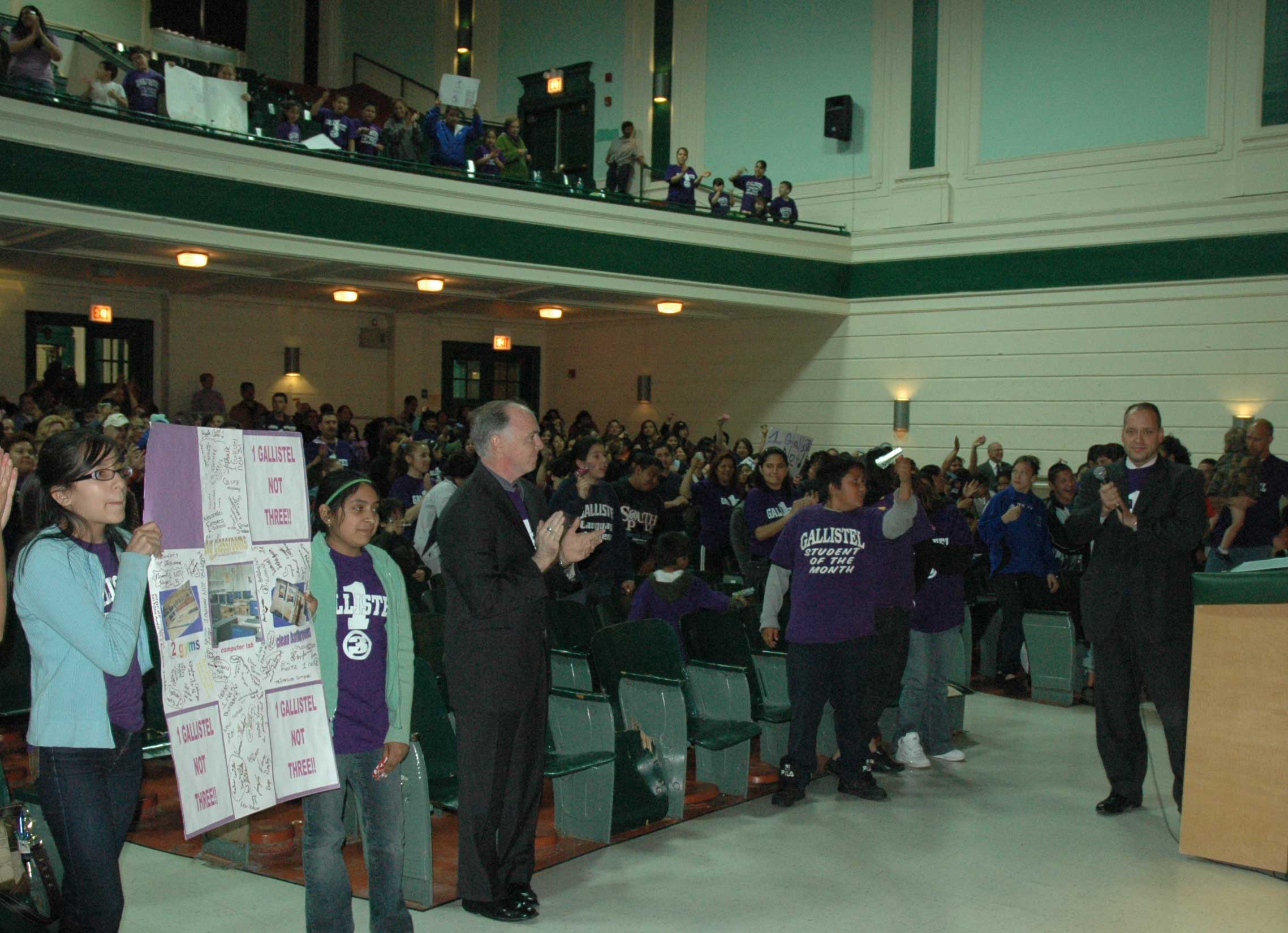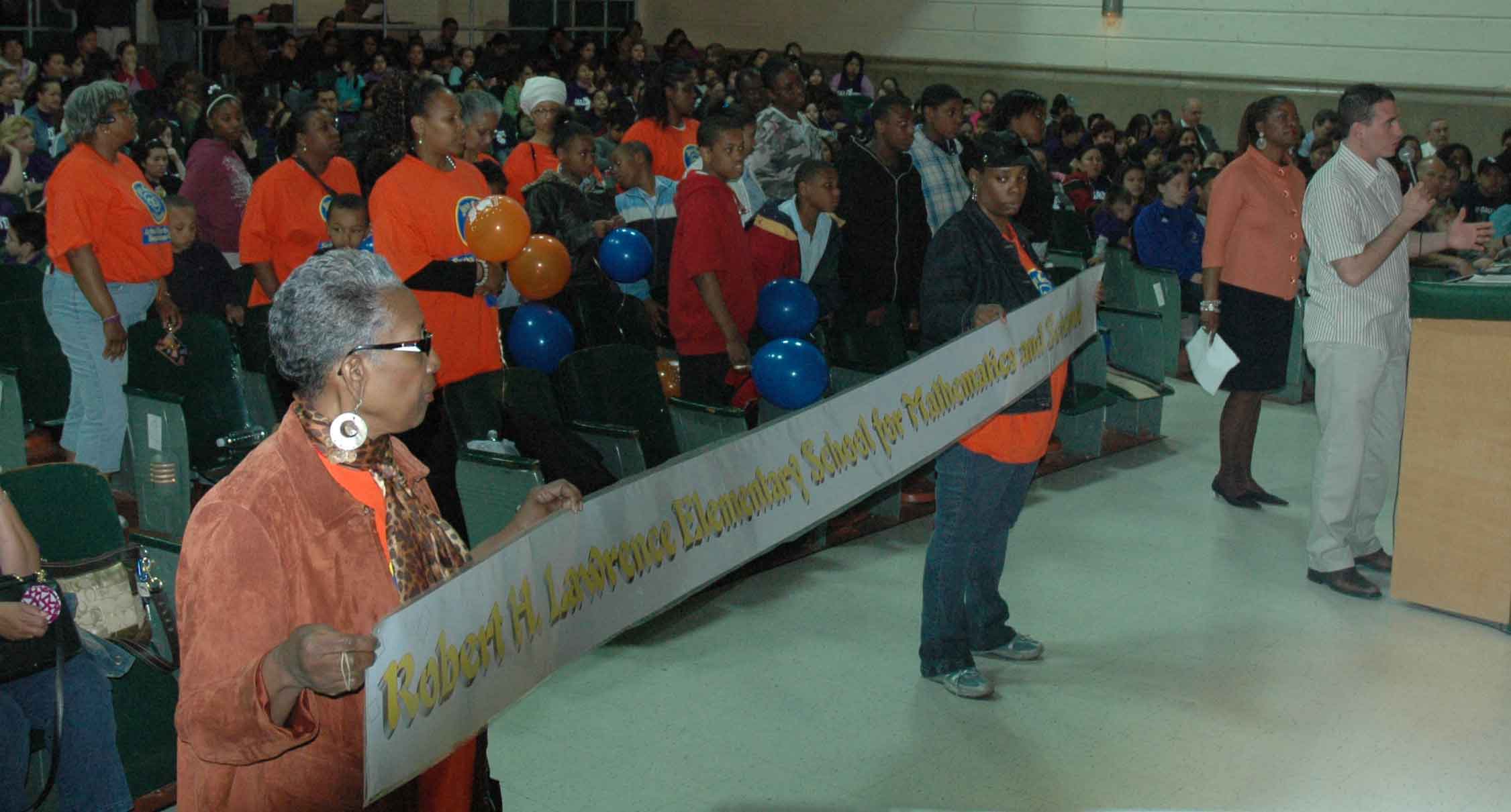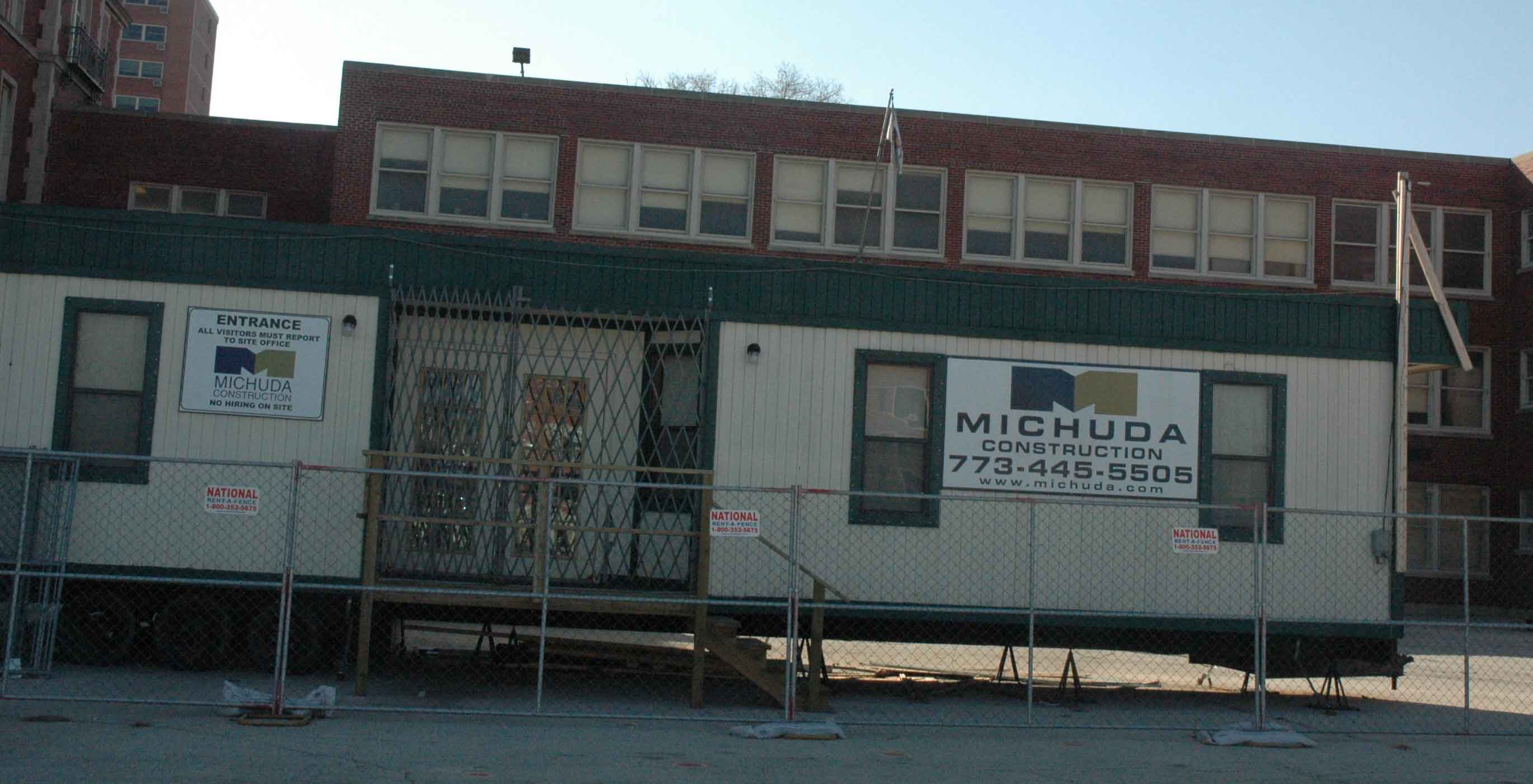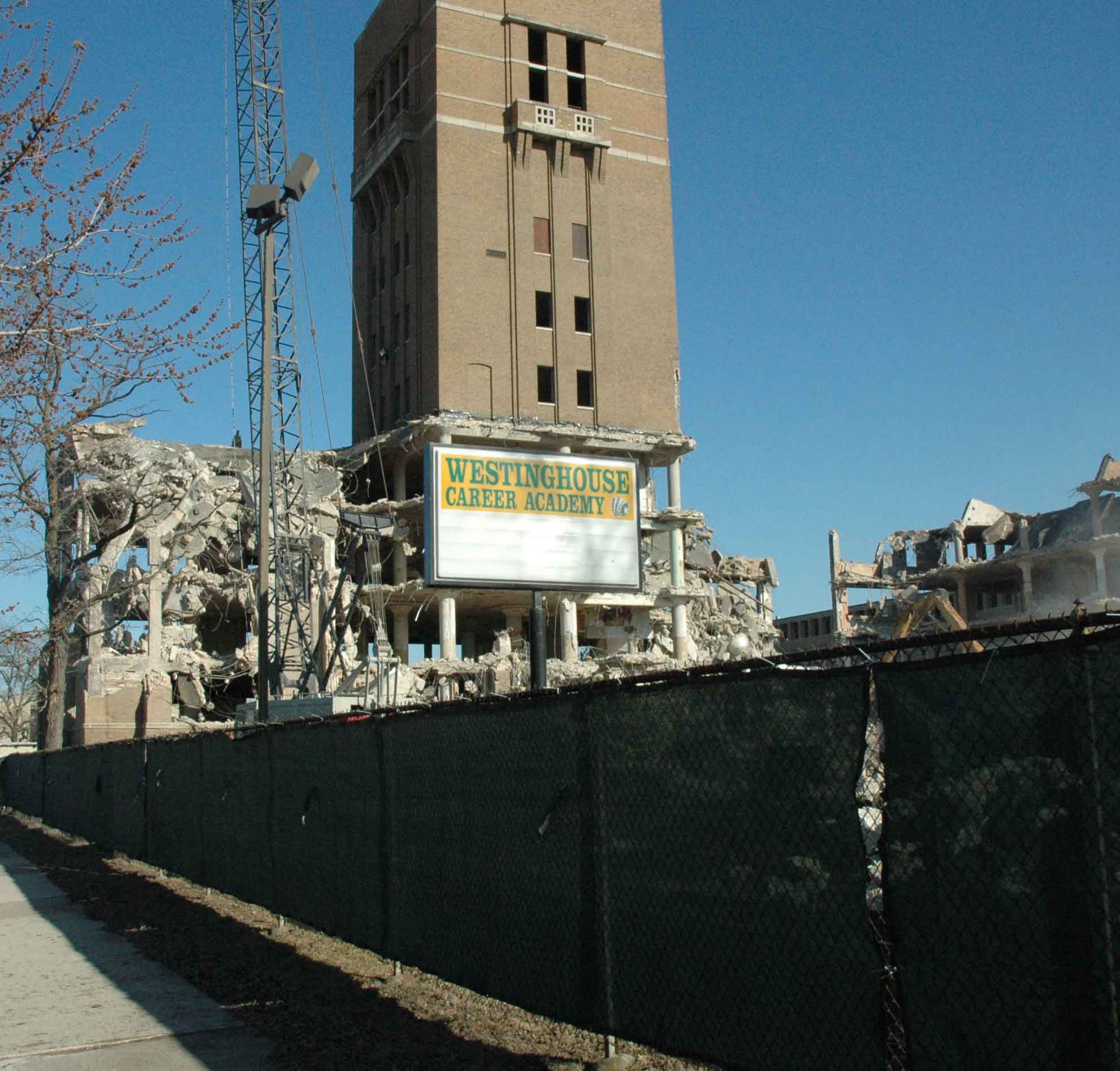Capital hearings draw hundreds, outline poor conditions at many Chicago schools
On May 22, 2008, while the eyes of Chicago’s media were elsewhere, hundreds of people ranging in age from two and three years old to senior citizens got off buses in front of Morgan Park High School on Chicago’s far South Side and entered the school auditorium for was the last of six hearings on the Board of Education’s “Capital” budget2. Holding a sign and wearing purple tee shirts that read “One Gallistel, Not Three”, more than 600 students, teachers, parents, and community supporters nearly filled the auditorium at Morgan Park High School on May 22, 2008. The Gallistel Elementary School contingent arrived by car and in 13 buses, making them the largest contingent to testify during the six-day hearings on the Board of Education’s Capital Development program in May. Standing at the podium on the right (above) and wearing his Gallistel tee shirt is Alderman John Pope (10th Ward) who spoke about the need for a new Gallistel school to consolidate the present three-school reality. Gallistel supporters filled most of the main floor of the large auditorium and the front row of the balcony. Whether Gallistel ever gets relief from its problems is another question, one not answered by the officials who hosted the hearings. Since Arne Duncan became CEO of the Chicago Public Schools in July 2001, schools like Gallistel, which proudly proclaim that they are public schools, have been short changed in all capital expenses, while school improvement and construction budgets are manipulated to support privatization schemes and other programs promoted by Chicago Mayor Richard M. Daley. Substance photo by George N, Schmidt.
Holding a sign and wearing purple tee shirts that read “One Gallistel, Not Three”, more than 600 students, teachers, parents, and community supporters nearly filled the auditorium at Morgan Park High School on May 22, 2008. The Gallistel Elementary School contingent arrived by car and in 13 buses, making them the largest contingent to testify during the six-day hearings on the Board of Education’s Capital Development program in May. Standing at the podium on the right (above) and wearing his Gallistel tee shirt is Alderman John Pope (10th Ward) who spoke about the need for a new Gallistel school to consolidate the present three-school reality. Gallistel supporters filled most of the main floor of the large auditorium and the front row of the balcony. Whether Gallistel ever gets relief from its problems is another question, one not answered by the officials who hosted the hearings. Since Arne Duncan became CEO of the Chicago Public Schools in July 2001, schools like Gallistel, which proudly proclaim that they are public schools, have been short changed in all capital expenses, while school improvement and construction budgets are manipulated to support privatization schemes and other programs promoted by Chicago Mayor Richard M. Daley. Substance photo by George N, Schmidt.
The hearings had begun three weeks earlier and had been held on two nights each week beginning on the North Side at Payton High School and Bell Elementary and ending on the far South Side at Morgan Park High School. During the three weeks, CPS stenographers took testimony that ultimately filled 181 pages. CPS officials from the Operations office received dozens of books, some quite hefty, with photographs showing the conditions at dozens of schools. The problems ranged from a few broken things to major problems involving crumbling roofs, walls that were no longer whole, and windows that let snow into in winter and oppressive heat in summer.
Between May 7 and May 22, 2008, the Chicago Board of Education hosted six hearings on its Capital Improvement Program (CIP). The hearings took place every evening at 5:30 p.m. Schools were notified, and other methods of communication sent out the word about the hearings. While their engineer Paul Casasanto delivers a detailed outline of the needs of their school (above right, standing with principal McClinton), parents and staff from Robert H. Lawrence Elementary stand during the May 22 hearing at Morgan Park High School. One of the newest trends at Chicago schools is that the school community designs a tee shirt when the school has to present its problems to the Board of Education. On May 22, Gallistel appeared in purple, while Lawrence was in red. Substance photo by George N. Schmidt.
While their engineer Paul Casasanto delivers a detailed outline of the needs of their school (above right, standing with principal McClinton), parents and staff from Robert H. Lawrence Elementary stand during the May 22 hearing at Morgan Park High School. One of the newest trends at Chicago schools is that the school community designs a tee shirt when the school has to present its problems to the Board of Education. On May 22, Gallistel appeared in purple, while Lawrence was in red. Substance photo by George N. Schmidt.
The first hearing was held on May 7 at Walter Payton High School. The following schools testified: Walter Payton College Prep High School; De Diego Elementary; Burley Elementary; Falconer Elementary; Duprey and Von Humboldt elementary schools (which are being combined this summer as the Board voted February 27 to close Duprey); and Goethe Elementary
The second hearing was held on May 8. Alderman Schulter (47th Ward) praised the mayor and spent more than five minutes trying to blame all of the problems in the CIP program on Springfield. Schulter went out of his way to repeat the CPS talking points about the great job done by the mayor.
The schools presenting on May 8 were: Bell Elementary School; Canty Elementary School; Wildwood Elementary School; Lyon Elementary School; Steinmetz High School; Decateur Elementary School; Hibbard Elementary School; Bateman Elementary School; Belding Elementary School; Palmer Elementary School; Lane Tech High School; Barry Elementary School; Sauganash Elementary School; Taft High School; O.A. Thorp Elementary School; Kelvyn Park High School; Edgebrook Elementary School; and Belmont-Cragin Elementary School.
The third hearing was held May 14. The schools that were represented included all of the overcrowded largely Hispanic schools on the Southwest Side and others: Mitchell Elementary; Jackson Language Academy; Herzl Elementary; Pickard Elementary; and Lawndale Community Academy. Although many communities have been promised repairs and improvements for years, Mayor Daley has the power to drive major improvements quickly. Much of the money Chicago schools are using for capital projects are going for charter schools and the expanding military academies the mayor promotes. Above, for example, the former Grant Elementary School, which was in need of repairs for more than a decade, is now being renovated at a cost in excess of $10 million. But it is now longer Grant Elementary. The building now houses two “military high schools”. Substance photo by George N. Schmidt
Although many communities have been promised repairs and improvements for years, Mayor Daley has the power to drive major improvements quickly. Much of the money Chicago schools are using for capital projects are going for charter schools and the expanding military academies the mayor promotes. Above, for example, the former Grant Elementary School, which was in need of repairs for more than a decade, is now being renovated at a cost in excess of $10 million. But it is now longer Grant Elementary. The building now houses two “military high schools”. Substance photo by George N. Schmidt
The fouth hearing, held on May 15 at Pershing West Elementary School and heard from: Pershing West; Mollison Elementary School; Haines Elementary School; Wells Prep Academy (inside Phillips High School); Mayo Elementary School; McKinley Park Elementary School; Dyett High School, and a group of schools represented by the Grand Boulevard Federation, a community group.
The fifth hearing was held May 21 at Lindblom College Prep High School. Schools that testified included: Lindblom High School; Dawes Elementary School; Pasteur Elementary School; Peck Elementary School; Canter Middle School; and Monroe Elementary School. A representative from Alderman Toni Foulkes was present, and a representative of Alderman Rey Colon spoke on behalf of Monroe Elementary School, which is on the Northwest Side. Also speaking May 21 was a representative of Alderman Willie Cochran (20th Ward) who presented the school officials with a spreadsheet itemizing the needs of every school in Cochran’s ward.
The final hearing was on May 22 at Morgan Park High School. The first school to speak was Lawrence Elementary. The dramatic presentation by Lawrence was followed by the even larger and more dramatic presentation from Gallistel. Several people spoke on behalf of Gallistel.
After the Gallistel contingent finished speaking and left the building, the following schools also presented their problems: Mount Greenwood Elementary School; Barnard Elementary School; and Dunne Elementary School.
The presentations on the needs of the schools from one end of Chicago to another and the dramatic photographs of the problems ranging from overcrowding to dangerous conditions could fill an entire book.
CPS staff were careful to point out at each of the hearings that CPS presently does not have a significant capital budget to help all of the schools that presented their problems at the hearings, but the turnout alone showed that the problems are growing, and that many (like Gallistel’s) have been around for ten years or more.
CPS Interim Director of Operations Heather Obora began each of the hearings with a lengthy statement that included the following: “The purpose of these hearings is to get your opinion, the opinion and recommendations of parents, community leaders, LSCs, principals, administrators, and students. As we develop and prioritize the Capital Improvement Program for next year, your input is extremely important to us as we use all this information to develop what we think is the best use of the Board’s funds in the next capital year.”
Obora continued by listing the three main goals of the Capital Program: “The first is to reduce overcrowding through new construction...” She also stated that achieving a minimal standard of physical well being and improved learning environments were also objectives.” The new Westinghouse High School is being built on Franklin Blvd. east of the site of the old Westinghouse (above, being demolished). The new Westinghouse will cost Chicago an estimated $100 million. While the school is being built adjacent to the site of the old school (demolition photograph from June 2008 above), the Chicago Board of Education has deprived the high school students of the community (Austin) of a general public high school for the past three years. After closing Austin High School as a general public high school, the Daley administration began slowly to privatize the Austin building. First came a charter schools ("Austin Entrepreneurship") whose clout was former Illinois State Schools Superintendent Michael Bakalis. A year after Bakalis was given a large part of the Austin building, a "polytechnic" contract high school was placed inside Austin. At the end of the 2007-2008 school year, high school age students from the Austin community were barred from attending the two small schools within the Austin building. Meanwhile, the Board of Education was spending $100 million (or more) on the new Westinghouse Vocational High School (above) while telling residents of Austin that there was no money to provide their children with a general public high school. Substance photo by George N. Schmidt
The new Westinghouse High School is being built on Franklin Blvd. east of the site of the old Westinghouse (above, being demolished). The new Westinghouse will cost Chicago an estimated $100 million. While the school is being built adjacent to the site of the old school (demolition photograph from June 2008 above), the Chicago Board of Education has deprived the high school students of the community (Austin) of a general public high school for the past three years. After closing Austin High School as a general public high school, the Daley administration began slowly to privatize the Austin building. First came a charter schools ("Austin Entrepreneurship") whose clout was former Illinois State Schools Superintendent Michael Bakalis. A year after Bakalis was given a large part of the Austin building, a "polytechnic" contract high school was placed inside Austin. At the end of the 2007-2008 school year, high school age students from the Austin community were barred from attending the two small schools within the Austin building. Meanwhile, the Board of Education was spending $100 million (or more) on the new Westinghouse Vocational High School (above) while telling residents of Austin that there was no money to provide their children with a general public high school. Substance photo by George N. Schmidt
The prepared remarks that began each of the six hearings also devoted a couple of paragraphs to outlining the achievements of the Capital Program since 1995, when Mayor Daley took over the city’s public schools. As usual, this part of the official history ignored the fact that for the 16 years prior to 1995 most of the Capital funds of CPS were frozen by the Chicago School Finance Authority. The pent-up demand for construction and rehabilitation was the result of more than a decade of neglect. The dramatic descriptions brought to the hearings by many schools cannot be summarized here. The only mention of the events in the corporate press came in a brief article in the Chicago Sun-Times, which covered the request from Duprey that Von Humboldt be repaired before the children from Duprey move into their new “school” (a section of Von Humboldt) this summer.

